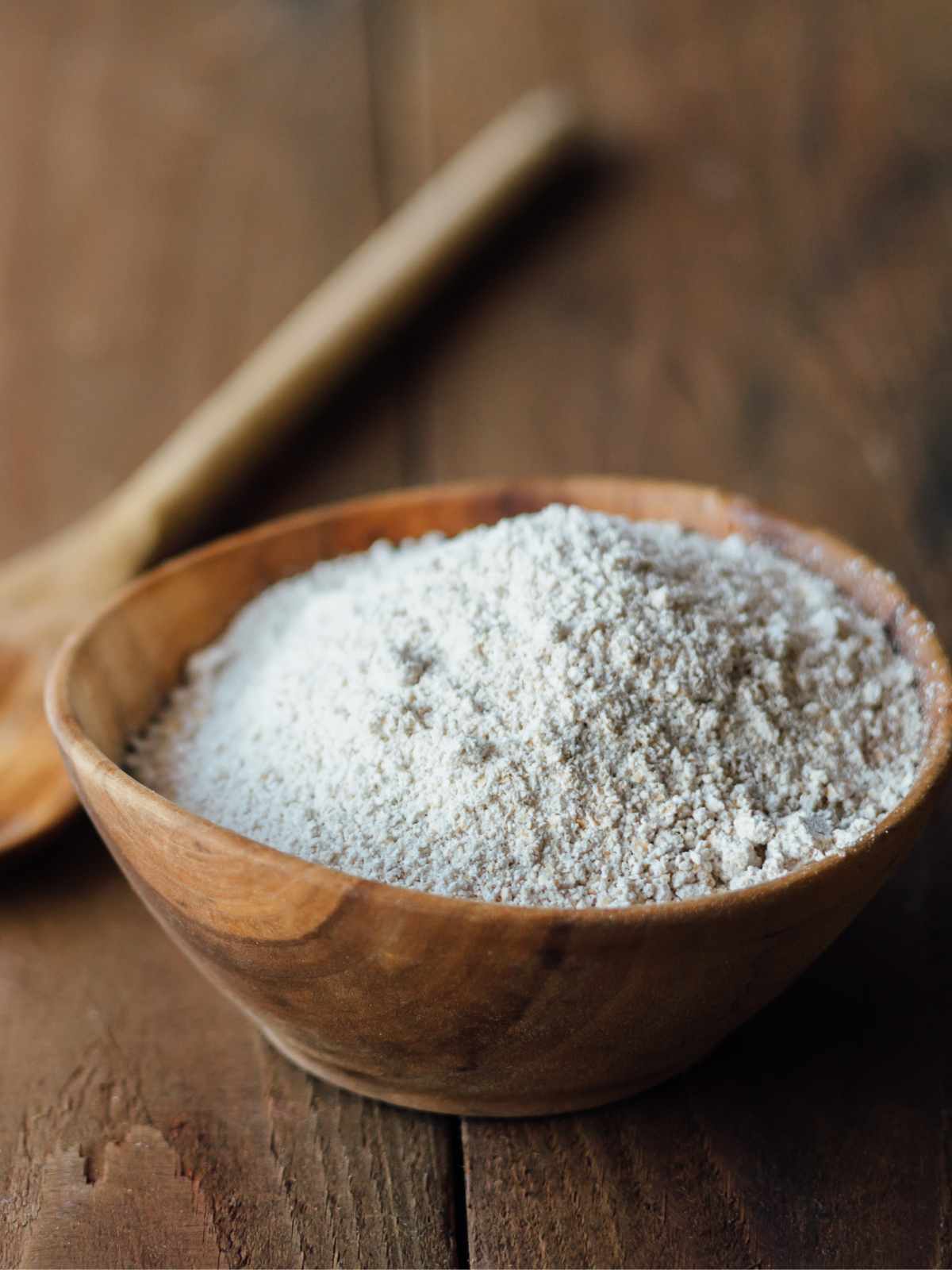Last Updated on March 14, 2023
Kamut is an ancient grain and Kamut flour is a nutrient-packed whole grain flour that is made from this ancient wheat. It is sure to take your culinary skills to the next level once you know how to use it!
Not only does it have an earthy, nutty flavor, but it also contains essential vitamins and minerals that are hard to find in other flours. Are you ready to add a little something extra to your recipes? So why wait? Get baking with Kamut flour today and enjoy delicious results!

What Is Kamut Flour
Kamut flour is made from kamut, which has been used for centuries in Mediterranean, Ancient Egyptian, and Middle Eastern cuisines.
Its use is becoming increasingly popular among health-conscious home cooks and professional chefs alike as more information about its nutritional benefits is discovered.
Unlike white wheat flour, Kamut flour contains all of the grain’s natural bran and germ cells. This is also a major plus for those concerned about getting all the vitamins, minerals, fiber and other beneficial compounds packaged within the grain’s natural protective layers.

Naturally high in phosphorous, zinc and magnesium but low in gluten content compared to traditional wheat varieties, Kamut Pasta supplies essential trace minerals while offering consumers a delicious “whole grain” meal experience when cooked “al dente.”
Due to its unique flavor and texture that is unlike traditional wheat flour. It can be used as an alternative to white wheat flour or substituted in recipes to replace other grains like rolled oats or barley.
Plus, it has a very high protein content, making it great for cooking hearty dishes like sourdough breads, wheat breads, flatbread, and pizzas, or baked goods like cookies and cakes. People found Kamut flour to be great for thickening soups and stews.
So, What Is Kamut?
Kamut is an ancient grain variety known for its highly concentrated nutrients as well as its distinct flavor profile. It has a rich golden color of the grain.
The Ancient Egyptian word for wheat is kamut. It is also known as Khorasan wheat or Oriental wheat grain, which is one of the tetraploid wheat species.

This ancient type of wheat that has been grown for thousands of years. According to legend, the fertile Crescent in the Middle East is where it originated.
The appearance of Kamut wheat is very similar to that of modern wheat. However, the grain is twice the size of modern-day wheat, and has a distinct rich, nutty and buttery flavor.
Benefits of Organic Kamut Wheat Flour
As with many ancient grains, kamut flour is a great source of dietary fiber, containing almost twice the amount that regular whole wheat flour provides. This has been linked to improving digestibility, as well as potential disease prevention.
Kamut flour is also high in magnesium and zinc, which are essential minerals for several bodily functions. Its protein content (a 3.5 ounce serving contains around 27% of your daily value) is relatively high compared to other flours.
It contains vitamins B-6 and E which are important for the health of your heart and skin. It also has significantly more lipids (fats) than regular whole wheat flour and a balanced blend of mono-, di- and polyunsaturated fatty acids, making it a healthier option for baking goods that require fats such as cakes and cookies.

Although not as popularly known as other superfoods like quinoa or chia seeds, kamut contains higher levels of most of the important antioxidants – usually between 10% – 20% more compared to its relative wheat berries, which helps reduce oxidative damage from free radicals in our bodies.
When cooking, its distinct flavor brings out the natural sweetness in sweet dishes without requiring you to add sugars or syrups – this characteristic makes it popular among health-conscious bakers.
It also can be easily incorporated into most baking recipes that call for basic wheat flours in order to add a unique nuttiness while providing nutritional benefits of an ancient grain – giving you all the more reasons to use it!
Is Kamut Flour Gluten Free?
If you’re wondering if Kamut® is gluten-free, the short answer is no, it’s not gluten-free.
Since it is a relative of durum wheat, as a result, it contains wheat and gluten. Therefore it is not recommended for those who have gluten intolerance.

What Is Kamut®?
The Kamut® is a registered brand name for Khorasan wheat, which is used by Kamut International, Ltd. Kamut® is used in a variety of food products, including breads, pasta, and cereals.
How to Use Kamut Flour
It is an excellent substitute for refined grains and can be used in a variety of recipes. The nutty, yet sweet flavor is perfect for baking, and its high concentration of vitamins and minerals make it a valuable addition to any pantry.
When used in baking, kamut flour must often be combined with another type of flour as it lacks the gluten content necessary to create the right texture for most baked goods. Generally, one-third of the total amount of flour should be kamut and the rest can be any whole grain or white flour that you prefer.

Due to Kamut’s lack of gluten also means that doughs using Kamut as the primary ingredient will not rise as much as those that use wheat products, Many recipes must also include longer rising times or additional leaveners if they are to yield satisfactory results.
Kamut’s flavor is complimented by:
- Whole grains such as oats, spelt or buckwheat;
- Nuts such as almonds or walnuts; and
- Fruit such as apples or blueberries.
Its mild sweetness makes it ideal for pancakes, waffles, baked pastas and breads. When used in light wheat-based breads like focaccia breads or tortillas, breadcrumb coatings made with kamut flour add a delightful crunchy texture while also providing added health benefits from its nutritious dimensions.
Additionally, breakfast cereals using only organic products like a custom-blend of flakes provide an excellent alternative to traditional sugar-loaded cereal mixes without sacrificing what makes them so popular to begin with – excellent taste!
Substituting Kamut Flour in Recipes
In baked goods, kamut flour adds structure while also providing a distinct nutty flavor. It can be used to replace up to half of the all-purpose flour in recipes such as yeast breads, cakes, muffins, cookies and even pancakes and waffles with only minor adjustments to liquid levels or baking times.
It does have a slightly different absorption rate than many gluten flours, so you may need to adjust the moisture ratio slightly when adapting your recipes.
Kamut flour works especially well as part of a blend because it can help to reduce the bitterness of some whole grain flours like spelt or rye. In addition, it provides structure and sweetness.
When substituting kamut for larger amounts of wheat flour in pizza crusts or flatbreads, add oil for a soft crust when replacing about 75% of the all-purpose flour with kamut in otherwise unchanged measurements – more oil will help prevent hard edges from forming when baking at high temperatures since kamut has fewer proteins that form gluten strands than come with modern wheat flours.
Storage and Shelf Life
Kamut flour should be stored in an airtight container and kept in a cool, dark place. It can be stored in the pantry, cupboard, or freezer for up to 6 months.
However it is best if it is used within 3 months. Once opened, it should not be used if the container emits a musty odor.

This ancient grain flour can also be purchased in pre-packaged bags that contain either a one-pound or two-pound package of kamut flour. It is important to note that Kamut flour has largely supplanted wheat and spelt flour in many parts of the world due to its superior nutrition profile.
Therefore it is necessary for consumers to check the packaging for information about whether or not the flour was made from organic kamut grain.
Proper storage will help preserve Kamut flour’s freshness and extend shelf life; it may still taste good after approaching 6 months aged, however its nutritional value may diminish as time passes. When possible use a small quantity of Kamut flour each time you bake with it so as not to waste anything remaining at the end of its shelf life.
Final Thoughts on Kamut Flour
Before using kamut flour, it’s important to realize that it has a distinctly nutty flavor and contains more protein than wheat flour. This type of flour is best used in combination with other flours, such as wheat or rye. In order to achieve the desired texture and taste. It is not recommended for baking delicate pastries or cakes due to its density.
It is especially beneficial for those on special diets, such as low-carbohydrate lifestyles because it has significantly fewer carbohydrates than wheat and isn’t as processed.
With the right recipes and mindful consumption habits, this unique wheat variety can add a distinctively nutty flavor to any meal while providing essential nutrients needed for optimal health.

More Food Info You’ll Like…
- What Does Vegemite Taste Like?
- Cornichons : How to Use?
- What is Farina?
- What is Blue Lotus Tea?
- What are Bitters?
- What is Maca Coffee?
- Espresso beans vs. coffee beans
- What is Chai? The most satisfying cuppa in the world!
- Mushroom Coffee: Shroom Coffee is all the rage these days!
- Kona Coffee: Best Hawaiian coffee that you can’t miss out!
- What Is Blue Matcha (Butterfly Pea Flowers)
- Does white tea have caffeine?
- Pink Oyster Mushroom Guide
- Blue Oyster Mushroom Guide
- Lion’s Mane Mushroom Recipes
- 28 Oyster Mushroom Recipes
- Bean Curd: What exactly is it?
- Mace Spice? What is it?

How to Substitue Kamut Flour In Baking
Ingredients
Instructions
- 1. In baked goods, kamut flour adds structure while also providing a distinct nutty flavor. It can be used to replace up to half of the all-purpose flour in recipes such as yeast breads, cakes, muffins, cookies and even pancakes and waffles with only minor adjustments to liquid levels or baking times.
- 2. When substituting kamut for larger amounts of wheat flour in pizza crusts or flatbreads, add oil for a soft crust when replacing about 75% of the all-purpose flour with kamut in otherwise unchanged measurements – more oil will help prevent hard edges from forming when baking at high temperatures since kamut has fewer proteins that form gluten strands than come with modern wheat flours.
Sign Up to Joyful Dumplings!
Subscribe to our mailing list and join our community!
Thank you for subscribing.
Something went wrong.








